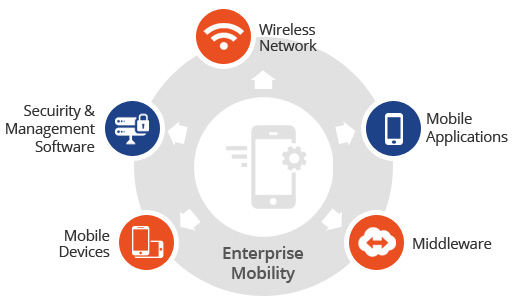The influx of high capability smartphones and similar handheld devices has brought dramatic changes to the world of modern communications. Demand for such devices is at its zenith point because these communication means are equally beneficial both for individuals as well as business enterprises. When it comes to managing diverse mobility needs, getting support for using these devices in the workplace and accessing sensitive information for commercial purposes, enterprise mobility management (EMM) plays a major role and make the corporate functionality smooth and hassle-free. And it can be easily made possible with custom and integrated business intelligence (BI) apps.

A strong EMM strategy assists employees become more productive by rendering them the tools they need to perform work-related tasks on mobile devices. With the next generation technology, business enterprises of all sizes and types can conveniently mobilize their workforce, their websites and their services. The EMM involves three different aspects. These include:
- Mobile device management (MDM): It relates to the locking down of mobile devices.
- Mobile application management (MAM): It relates to users’ restricted access to apps.
- Mobile information management (MIM): It relates to allowing only approved applications to access corporate data.
Why Enterprise Mobility Management?
There are approximately 71% of enterprises deploying mobile apps. The number of enterprise smartphones and tablet app users is increasing day-by-day. Even, 73% of businesses rated increased efficiency as an important benefit of mobile computing. The list of such data and statistic is exhaustive. There are a lot of benefits of using EMM for the commercial purpose. These include:
– Embrace Bring Your Own Device (BYOD) trend.
– Secure corporate apps, data, and devices.
– Reduce complexity and simplify mobile strategy.
– Boost productivity and reduce costs.
Enterprise applications are customarily designed to integrate with other enterprise applications used within the organization. They are also deployed across a variety of networks: Internet, Intranet and corporate networks while meeting strict requirements for security and administration management.
Although enterprise apps are usually designed and deployed in-house by a specialized IT development team, yet you can outsource the task to a professional and experienced Mobile development company known for enterprise Mobile development services. Some of the more common types of enterprise applications include: Automated billing systems, Payment processing, Email marketing systems, Content management, Call center and customer support, Customer Relationship Management (CRM), Enterprise Resource Planning (ERP), Business Intelligence, Business Continuity Planning (BCP), HR Management, Enterprise Application Integration (EAI), Enterprise search and Messaging and collaboration systems.
Continuous testing of ideas and solutions, BYOD, increased cloud activity, natively made enterprise mobility, investment in mobile application, and innovation are some of the trends that you will see this year. These trends can be an opportunity to excel and make ways for the companies that deal in the development of high quality enterprise apps. In the same manner, these trends can businesses get more mobility in their services, productivity and men force.
To sum up, the combination of devices, apps and information is key to a successful EMM within an organization.


 admin
admin